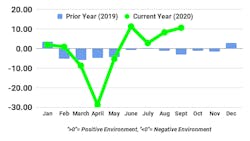FTR’s TCI continues rise in September
FTR’s Trucking Conditions Index rose again in September to a positive reading of 10.69, up 2+ points from August. September’s TCI – the third highest reading since January 2010 – reflects strong freight rates mostly due to the intense stress in the consumer goods supply chain.
Details of the September TCI are found in the November issue of FTR’s Trucking Update, published October 30. Additional commentary discusses the confluence of factors that are spurring an unprecedented surge in newly authorized motor carriers. Beyond the TCI and additional commentary, the Trucking Update includes data and analysis on load volumes, the capacity environment, and rates. FTR also publishes ongoing publicly available analysis on the impact of COVID-19 on freight transportation at FTR’s COVID-19 intelligence.
“We envision trucking conditions remaining strong for a while – probably well into 2022 – although we could see some near-term softness once we normalize retail inventories,” said Avery Vise, vice president of trucking, FTR. “An industrial recovery should support broad-based growth in freight volume. Robust spot rates already are starting to push up rates in the much larger contract arena, and constraints on the driver supply stemming from the pandemic likely will maintain that pressure. However, continued strong economic recovery is not secured given the latest surge in COVID-19 infections and a political environment that likely makes further relief and stimulus more difficult. The road ahead is still not crystal clear.”
The TCI tracks the changes representing five major conditions in the U.S. truck market. These conditions are: freight volumes, freight rates, fleet capacity, fuel price, and financing. The individual metrics are combined into a single index indicating the industry’s overall health. A positive score represents good, optimistic conditions. Conversely, a negative score represents bad, pessimistic conditions. Readings near zero are consistent with a neutral operating environment, and double-digit readings in either direction suggest significant operating changes are likely.
